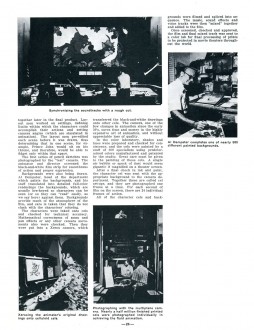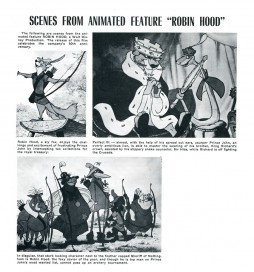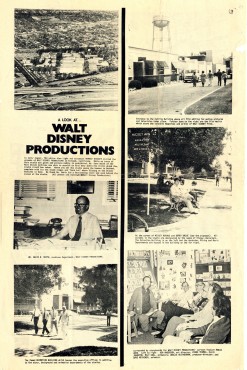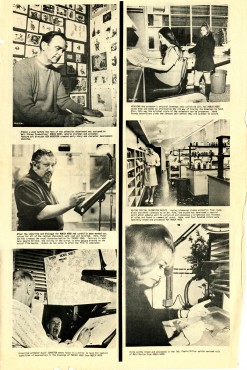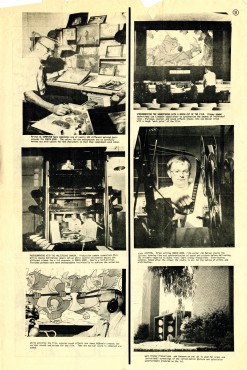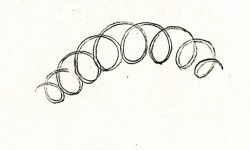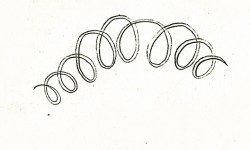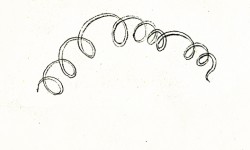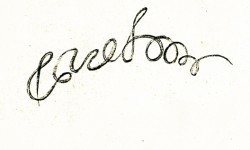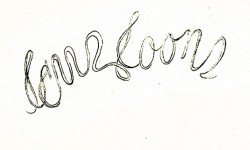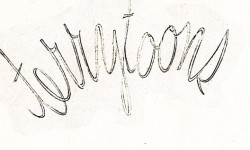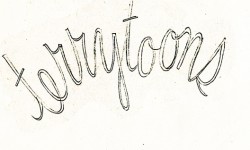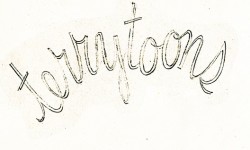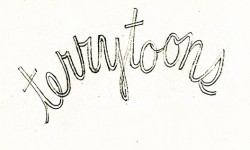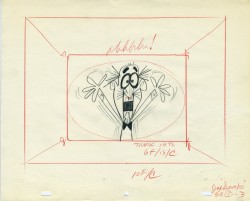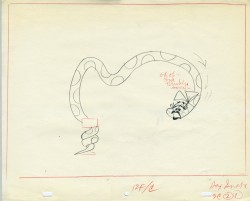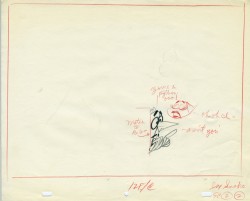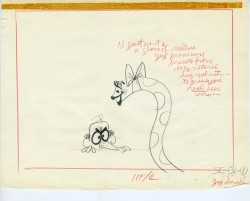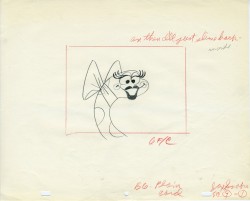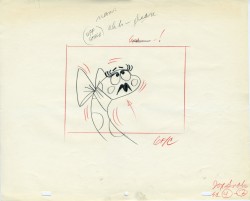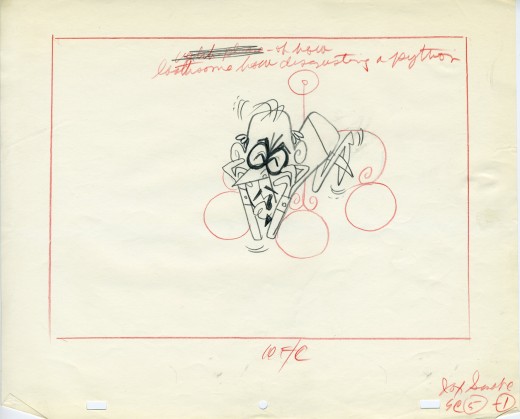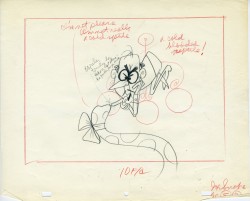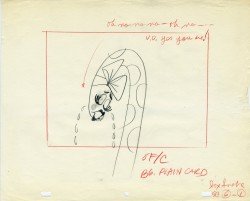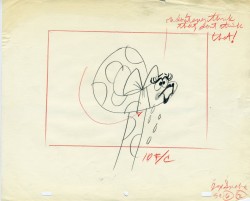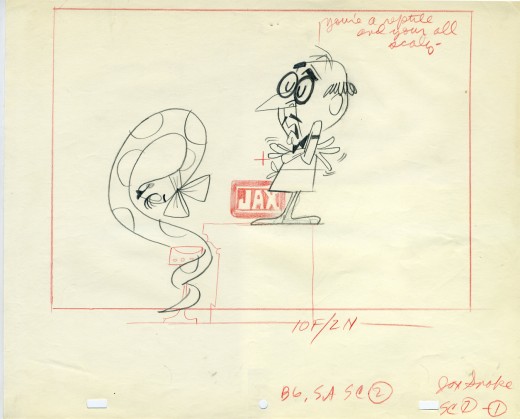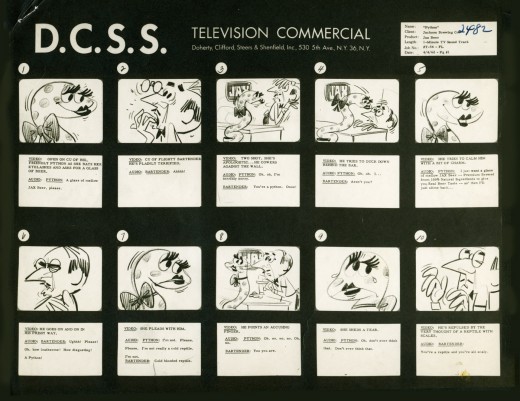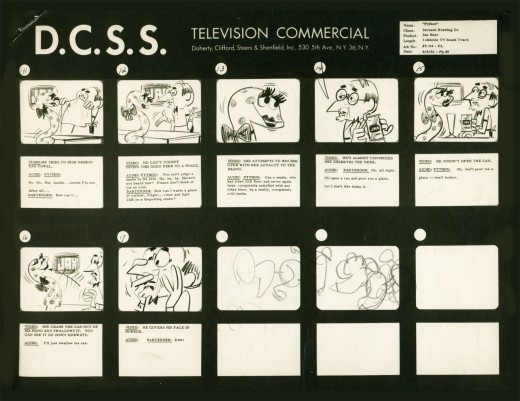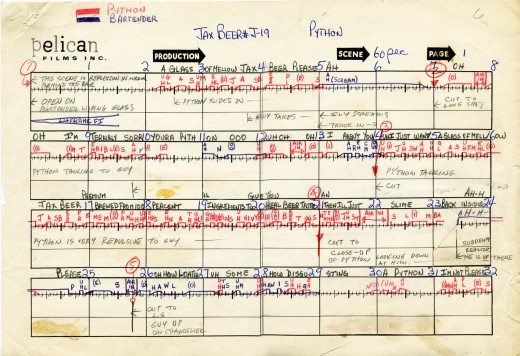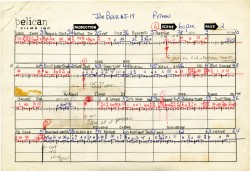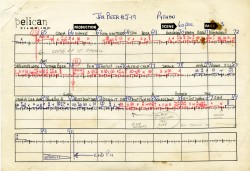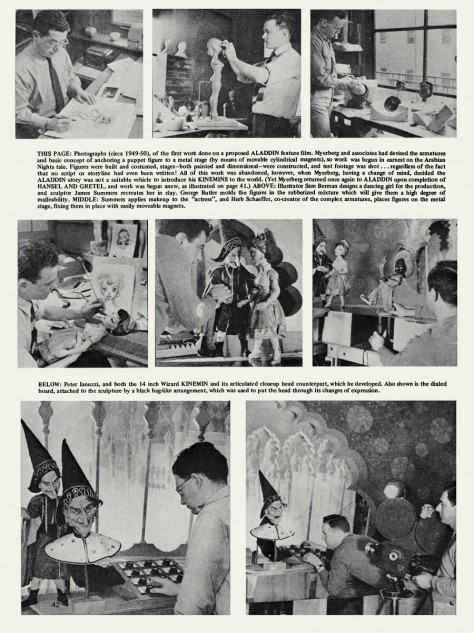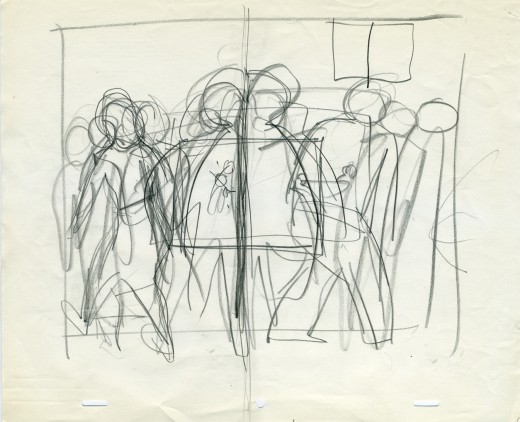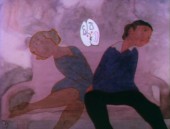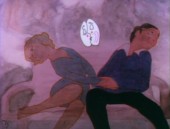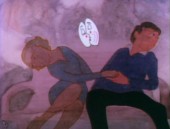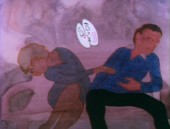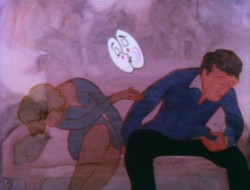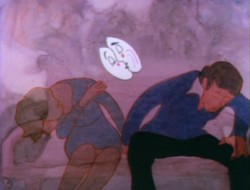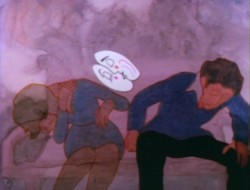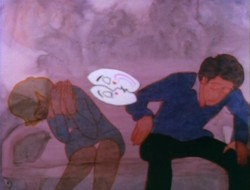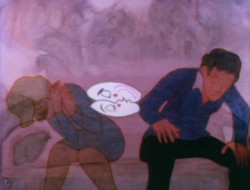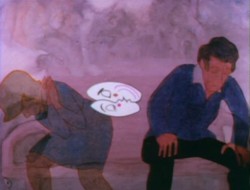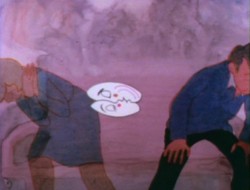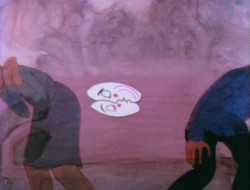Category ArchiveAnimation Artifacts
Animation Artifacts &Daily post 21 Nov 2006 07:46 am
Norman McLaren At MOMA
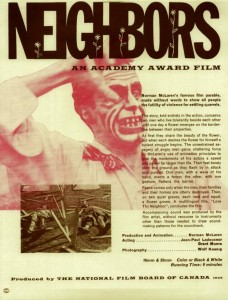 – The Museum of Modern Art will be celebrating the pioneering work of Norman McLaren by screening some newly stuck 35mm prints of some of his key works.
– The Museum of Modern Art will be celebrating the pioneering work of Norman McLaren by screening some newly stuck 35mm prints of some of his key works.
This also celebrates the recent issuing of a new DVD set of McLaren’s complete works by the National Film Board of Canada.
Norman McLaren: Master’s Edition
MoMA will present this eleven-film program on Nov.29th and 30th, which demonstrates the imagination, vitality, and versatility of the artist’s animation.
The program includes Opening Speech, Stars and Stripes, Hen Hop, Begone Dull Care, A Chairy Tale, Lines Horizontal, Blinkity Blank, La Merle, and Neighbors.
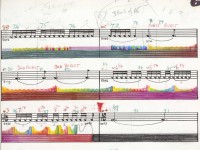 I urge you to attend since there aren’t often screenings of these films in 35mm. Maybe it’s just me, but somehow, it doesn’t feel the same in dvd or ipod.
I urge you to attend since there aren’t often screenings of these films in 35mm. Maybe it’s just me, but somehow, it doesn’t feel the same in dvd or ipod.
We’re living in a world where everything has to be handed to us. When an artist, such as McLaren, comes along with films that are slightly abstract and force us to use our imaginations, films that have a strong intellectual content, we have to bask in the glow and absorb the inspiration.
(Images enlarge by clicking them.)
Wednesday, November 29, 6:00;
Thursday, November 30, 8:30.
The Celeste Bartos Theater
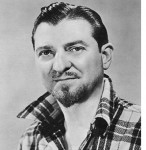 – To move to an artist of a different sort, I received a comment on my Splog (original post here) from Thaddeus Seymour who is the son-in-law of TV art instructor, Jon Gnagy. I’d written a post about Gnagy and talked about the impression that his art instruction made on a young me.
– To move to an artist of a different sort, I received a comment on my Splog (original post here) from Thaddeus Seymour who is the son-in-law of TV art instructor, Jon Gnagy. I’d written a post about Gnagy and talked about the impression that his art instruction made on a young me.
Thaddeus wanted to announce that he and wife, Polly, have put together a new site memorializing Gnagy which includes ten episodes of his show in YouTube format. Manna from heaven.
This may serve as a trip down memory lane for many; it may serve as art instruction for others. Either way it’s entertaining and informative about a television program that was big in the 40′s & 50′s.
Go here for the site.
Go here to order a Jon Gnagy kit.
Thank you Thaddeus and Polly Seymour.
Animation Artifacts 18 Nov 2006 08:58 am
Old Article Day
- I have a couple of articles that were printed in 1973 for the first release of the Disney “Classic”, Robin Hood.
At least, Disney calls it a classic; I’ve always had some trouble staying awake through it. The repetitive use of the xeroxed cycles gets dull, and the story is not developed dramatically enough for my taste. It doesn’t take itself seriously enough. (Disney released a much better non-animated Robin Hood in 1952 starring Richard Todd.)
There are moments of good animation, particularly Ollie Johnston’s dialogue between Sir Hiss & Prince John.
The decline had started on The Jungle Book and The Aristocats, but by and large, to me, this film proved once and for all that Disney was dead. All that was left were glimmers of interesting animation. The Rescuers made a valiant attempt to come back, but The Black Cauldron is unwatchable. (Of course, this is just my opinion.)
The first of the two articles below, is taken from a Local 831′s union paper. It was written by Ken Anderson, which is the prime reason for posting it.
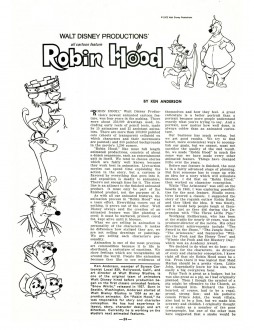 1
1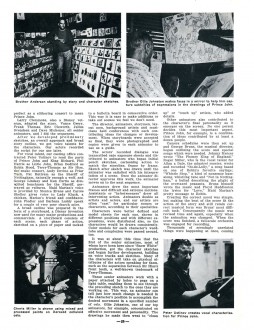 2
2
(Click any image to enlarge)
The pictures in the first article are not the best quality, hence I post this second piece, which even on newsprint, gets the photos to look better.
Obviously both used the Disney marketing package to pull photos for illustration. In this second article, I’ve flopped a couple of pictures. It didn’t matter to the publication that the writing in the photos (on model charts etc.) was illegible.
Animation Artifacts 16 Nov 2006 07:40 am
Terrytoons Logo
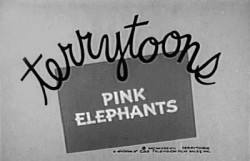 – Since first seeing them in the 50′s, I’ve been a fan of the films from the Gene Deitch period at Terrytoons. You know, Clint Clobber, Sidney the Elephant, Gaston Le Crayon and Tom Terrific. Call this a guilty pleasure.
– Since first seeing them in the 50′s, I’ve been a fan of the films from the Gene Deitch period at Terrytoons. You know, Clint Clobber, Sidney the Elephant, Gaston Le Crayon and Tom Terrific. Call this a guilty pleasure.
The animated logo included a linear face which had some scribbled hair that animated to read “Terrytoons” when a door closed on it.
(This is the logo used as a title card.
From ASIFA Hollywood Animation Archive.)
I have copies of the drawings for the animation of the type. Here they are:
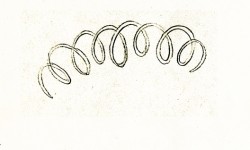 1
1 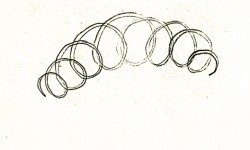 2
2
(Click any image to enlarge.)
Animation Artifacts &Daily post 15 Nov 2006 08:57 am
George C + 2 Rettas + John K
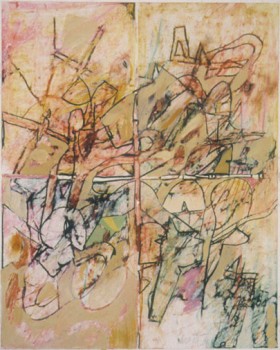 – A short note left on my blog shared the news that George Cannata is a teacher at the Art Students League.
– A short note left on my blog shared the news that George Cannata is a teacher at the Art Students League.
Aside from the impressive animation biography, Mr. Cannata has a somewhat prestigious art training, himself. He began his art training at the Art Students League at the age of fourteen, studying with George Grosz. He graduated from the Chouinard Art Institute in Los Angeles and studied lithography with John Baldwin and drawing with Rico Lebrun at the Instituto Allende in Mexico.
The class description reads as follows: This class covers all aspects of drawing and composition,” he notes. “Both figurative and abstract approaches are explored in a variety of media. Students work from the model and from imagination. Individual and group critiques are frequent as I wish to produce a lively exchange of ideas. My desire is to open new avenues and to guide the students past any obstacles or inhibitions that may be preventing them from reaching their full creative potential. The class is open to beginners and advanced students.”
Classes are Monday-Friday 1:00 – 4:45pm and cost $185 per month. It’s a good way to develop the muscles while working with a great instructor.
- I’ve come to love the regular installments of Floyd Norman’s column on Jim Hill Media. Currently he writes about Retta Davidson. It’s nice to see a few articles appearing on-line about some of the females in animation history. Of course, Retta Scott‘s name sets off waves of curiosity. It’s interesting to hear about another Retta who thrived at the Disney studio without much fanfare. Thanks to Floyd for serving attention.
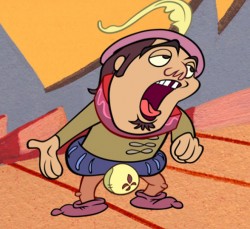 - For those who haven’t seen the latest John Kricfalusi animation music video for Jack Black‘s Tenacious D, go here.
- For those who haven’t seen the latest John Kricfalusi animation music video for Jack Black‘s Tenacious D, go here.
It’s a bit hard core, but has some wonderful elements in it. Kricfalusi developed a wonderful, vibrant relationship between characters and backgrounds in Ren & Stimpy. In this music video, he takes it to new levels and does some smashing work. The “multiplane” levelling works in the many ways it’s used; I particularly like it when it’s done subtly and quietly. That works well against the raucus style of animation; nice dynamic tension in that.
It’s nice to see some life in the medium.
Animation Artifacts 10 Nov 2006 10:25 am
Hans Perk
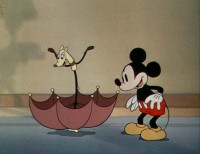 - Hans Perk on his site, A Film LA, has posted what I think is one of the most important pieces on the internet today – as far as animation goes.
- Hans Perk on his site, A Film LA, has posted what I think is one of the most important pieces on the internet today – as far as animation goes.
He has taken the Disney short, Thru The Mirror, and added a click track (aural and visual) to it. This is the finest representation of timing in animation that you’ll find. The cartoon is great, the animation is great, and the click track gives you the same focus the animator had. Go!
There’s nothing more valuable I can report today.
Animation Artifacts &Daily post 09 Nov 2006 09:00 am
Animation Shows & The Wan Brothers
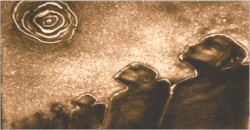 - The 8th Annual Animation Show of Shows will play in NYC on Friday, Nov 10th at 11am.
- The 8th Annual Animation Show of Shows will play in NYC on Friday, Nov 10th at 11am.
The films scheduled include:
He Who Cheats Doesn’t Win (Rajiv Eipe, Kaustubh Ray)
Danish Poet (Torill Kove)
Gentleman’s Duel (Francisco Ruiz, Sean
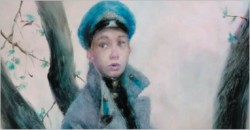 McNally)
McNally)
A My love (Alexander Petrov)
Shipwrecked (Frodo Kuipers)
No Time For Nuts (Chris Renaud, Michael Thurmeier)
Tragic Story With Happy Ending (Regina Pessoa)
Lifted (Gary Rydstrom)
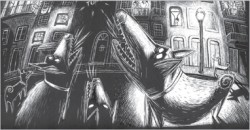 Some of the filmmakers will be in attendance to answer questions afterwards including:
Some of the filmmakers will be in attendance to answer questions afterwards including:
Torill Kove
Marcy Page
Regina Pessoa
Abi Feijo
Chris Renaud, and
Michael Thurmeier
FREE ADMISSION ! Come early, only 260 seats!
- There’s another excellent piece at the ASIFA Hollywood Animation Archive blog. They share with us a nicely illustrated presentation and translation of the biography of the Wan Brothers, who first started animating in China in 1925.
They are the artists behind the Princess Iron Fan, China’s first feature-length film completed in 1941. On the site, you can view both Uproar In Heaven and the documentary biography of the brothers.
Animation &Animation Artifacts 08 Nov 2006 09:14 am
Jax “Snake” LO’s
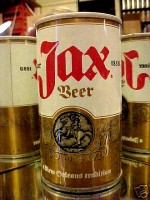 - Continuing with yesterday’s posted Jax Beer commercial, as promised, I am putting up some of the film’s layouts. This represents about 2/3 of them.
- Continuing with yesterday’s posted Jax Beer commercial, as promised, I am putting up some of the film’s layouts. This represents about 2/3 of them.
The art was done by Mordi (Mordicai) Gerstein, who also directed the spot. Grim Natwick animated the spot and Tissa David assisted him. Of course, this was in the days before auido tapes could be handed out, so the animator would get a phonograph of the soundtrack. They could mark it with a white pencil to indicate key spots.
I thought that this in conjunction with yesterday’s prep material gave a good indication of the preproduction that went into making a commercial back in 1962.
That said, here are the layouts:
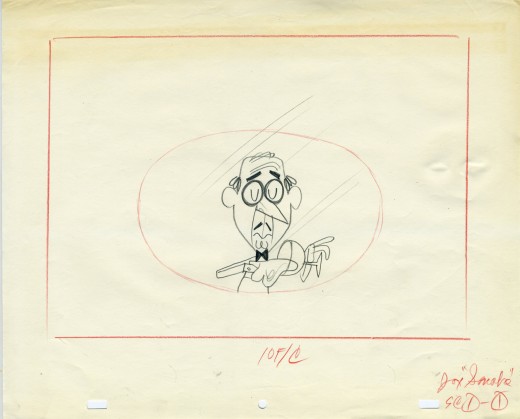
(Click on any image to enlarge.)
Animation Artifacts &Story & Storyboards 07 Nov 2006 08:44 am
Jax Beer Spot
- Here’s the material for a Jax Beer commercial. It was done by a NY studio named Pelican in 1962. There were about 75 people on staff at Pelican back then.
This spot was directed by Mordi (Mordicai) Gerstein. He left animation to write & illustrate children’s books in th 70′s. (He won the Caldecott Medal for his book, The Man Who Walked Between The Towers. This was the book I adapted to animation last year.)
What follows is the storyboard and the director’s workbook. (It appears to be an agency board, though it’s drawn in a style that looks to be Mordi Gerstein’s. Perhaps boards from the agency were drawn by the studios back in 1964; I’m not sure. The layouts were drawn by the same artist.)
Tomorrow I’ll post some of those layouts.
The workbook has several flaps on it that indicate changes in timings. There are also glue stains where I assume other flaps fell off. (See page one, last row, first column.) Each column represents 16 frames/one foot of film. Odd numbers are marked off.
Each row contains 8 feet of film/128 frames. Each page represents 32 feet/512 frames. It would have been smarter to keep to even numbers.
More modern exposure sheets generally have 80 frames/five feet per page. This also divides into two feet of 16mm film. (Handy.) The numbers add and divide smartly and easily. But then most people don’t use exposure sheets anymore.
Animation Artifacts 06 Nov 2006 08:33 am
Myerberg’s Aladdin
- This week I’d received an interesting comment on my “Splog” about Michael Myerberg‘s puppet feature, Hansel & Gretel. Since this post was done a time back, the comment could be easily missed. I’d like to draw some attention to it, since I rather enjoyed it:
I saw this movie during it’s initial run in 1954. I was three years old. The experience made such a lasting impact that it led me into a career in sculpting.
In 1999 I had the opportunity to take molds off the last known remaining puppet. It was of Rosina the Witch and the armatures designed by Jim Summers still worked as beautifully as they must have when the film was being shot.
In the early 1970’s I worked for one of the animators, Sky Highchief, who relayed a lot to me about the actual filming. The original plan had been to do an animated version of Aladdin, but this was dropped in favor of doing Humperdink’s opera as Hansel and Gretel was considered a better commercial risk. The film was shot in sequence. As money started running out for Myerberg and the release date loomed the push was on to complete the project in time. This accounts for the fluid animation at the front end of the film and the rather “muddyâ€, jerky movements of the characters at the end. Also all the Enchanted Children and Angles in the Dream Sequence have the faces of Hansel and Gretel. There was no time to do original sculpting for these puppets so they just pressed what had already been done into service. According to Highchief the New York studio was vandalized shortly after the film was completed and many of the remaining sets and props simply consigned to the trash bins. The film was not a success for Myerberg and plans for other stop-motion films abandoned.
I talked with members of the Myerberg family in early 2000 and they claim that all the original elements of the film are still intact. Considering the awful DVD currently available and knowing it’s place in stop-motion animation history I am amazed that nobody has taken it upon themselves to do a restoration.
from: David Robert Cellitti
As I wrote in response, I do have some information about the Aladdin feature that Myerberg had explored. Here’s the document:
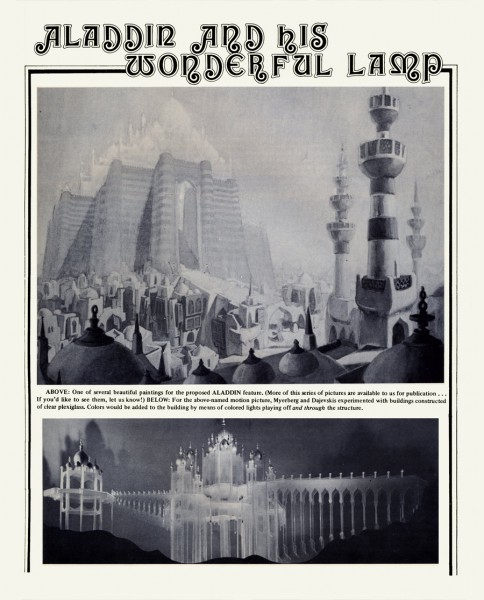
(Click on any image to enlarge.)
Animation Artifacts &Hubley &Tissa David 04 Nov 2006 09:10 am
Carousel LO
- One of my favorite experiences in my animation career was working on the Hubley film Everybody Rides The Carousel. This was a feature done for CBS. It was adapted from the work Childhood and Society by the noted psychologist, Erik Erikson‘s. His book was a treatise on the development of humans; he broke the stages of man down to eight.
In Hubley’s film, each stage was represented by a horse on the Carousel.
At the sixth stage, my favorite part of the film, two young adults find each other, fall in love, separate and come back together. The female Voice/Over was done by a Yale student in her first film role, Meryl Streep.
Here’s a layout by John Hubley, given to Tissa David for a seminal scene in the film. The boy and girl have fallen in love and present themselves to each other wearing symbolic masks; they cannot reveal their true feelings to each other. The masks, which don’t come off, cause them to grow apart and separate.
In this one rough drawing, John expressed volumes, and Tissa animated what is, to me, possibly the best scene in the film.
To show how it ended up, I’ve taken some key frame grabs from the actual film. The scene actually plays out slowly, and acts as a coda at the height of the sequence.
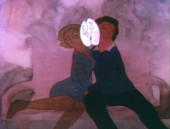 1
1 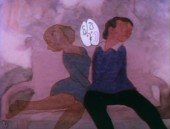 2
2
(Click any image to enlarge.)
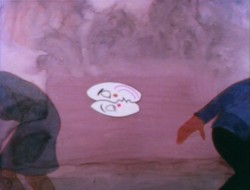 The artwork was colored on layers of vellum designed for architects. It came in rolls and had to be cut and punched. Little of the paper’s grain showed when it was bottom lit. The drawings were inked and colored with magic markers: water based ink lines and alcohol based fill colors. (This prevented the ink lines from smearing.)
The artwork was colored on layers of vellum designed for architects. It came in rolls and had to be cut and punched. Little of the paper’s grain showed when it was bottom lit. The drawings were inked and colored with magic markers: water based ink lines and alcohol based fill colors. (This prevented the ink lines from smearing.)
It was photographed from below – like a pencil test. To soften the background a blank layer of the vellum was used between the background and the characters. The masks were doubled into the scene after it was shot. They were filmed top-lit at 80% exposure.
This was the technique for this one sequence in the feature. Most of the rest of the show was shot traditionally, top lit. Each stage had its own technique and color scheme.
